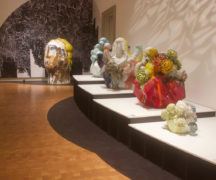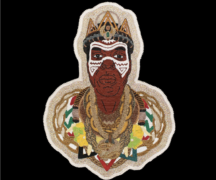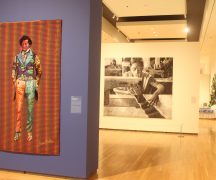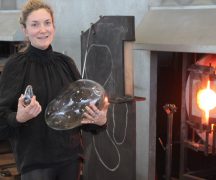By DAVID DUPONT
BG Independent News
The many peoples of what came to be known as North America were creating art well before the people of Rembrandt and Michelangelo arrived on these shores. Even as disease, war and dislocation took a horrendous toll on the native cultures, their urge to create beauty did not diminish, rather it took new turns and proved a path to survival. Individuals found a way to support themselves by creating, and their cultures found a way to perpetuate themselves through art, even in the face of oppression.
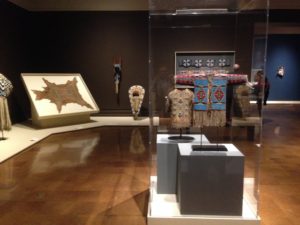
Indigenous Beauty: Masterworks of American Indian Art from the Diker Collection, an exhibit of art collected Charles and Valerie Diker, opens to the public Friday and continues through May 8. The exhibit contains about 120 works collected over 40 years by the Dikers.
The couple, said Valerie Diker during the press preview, consider themselves “custodians” of these treasures. Their mission is to use their collection to educate the public about the richness of the cultures of Native Americans. “This came from their hearts and souls,” she said. “There was much more depth to the Native American than most people understand. More than we first understood when we started collecting.”
“By exposing the non-Indian public to this work,” Charles Diker said, “they begin to understand the spirituality behind it, that there’s more to the pieces. It’s a way to educate the public about this art.”
The Dikers started collecting contemporary art more than 50 years ago. They then added pre-Columbian art to their purchases. It was when they first visited New Mexico, and later moved there, that their collection of “historical” indigenous work began.
This work from the 17th century on, is dynamic and innovative, while the pre-Columbian is more classical, he said. These were the first artists on the continent. Their influence resonating through the centuries influencing those contemporary artists the Dikers also collect.
The Dikers set about finding the best examples of work from throughout the continent. They were not satisfied with dolls, baskets or pottery from one particular region. “We’d look for the best pieces, the best objects from each area so we’d have an encyclopedic collection,” Charles Diker said.
Though native languages didn’t have words for “beauty,” the pursuit of beauty pervaded their cultures, Charles Diker said. “It was part of their DNA.”
People are losing that appreciation of beauty in the digital age, he fears. The exhibit is a reminder of its enduring power.
Halona Norton-Westbrook, the museum’s director of collections, noted that the work is displayed in the Canaday Gallery according to geographic regions, from Alaska back to the Eastern seaboard.
David Penney, the curator of the show, said three themes run through the exhibit.
The first is the beauty of the work and the “fastidious” craftsmanship. That aesthetic sense, he said, provived a way for Native Americans to build a bridge to other cultures.
The baskets by Louisa Keyser (also known as Datsolalee) of the Washoe people of Nevada, exemplifies how Native Americans used their craft to support themselves and reach out to non-natives. Her baskets were impeccably crafted, using traditional techniques to create her own distinctive designs. A Carson City business owner saw her work and helped her to market it.
Penney said that the exhibit demonstrates the diversity of the indigenous cultures from the Katsina Dolls of the Hopi and Pueblo Zuni of the southwest to the pictographs of the inhabitants of the plains. One of the most famous pictographs, a depiction of the Battle of Little Bighorn by Standing Bear, a Lakota warrior who participated in the battle, is on display.
The exhibit also shows the emergence of “a global economy.” Visitors can see how traditional ornamentation of animal hair wrapped around porcupine quills gave way to glass beads manufactured in Venice. A waistcoat from the east uses a mix of native and European materials for a garment with a fashionable European cut. Imagery from across the seas, a Spanish coin design or a paisley pattern, find their way onto articles of clothing.
While most of the objects are historical, the Dikers have also purchased contemporary art that reflects both traditional imagery and new techniques. That includes Preston Singletary’s striking “Oystercatcher Rattle” made of blown and sand-carved glass and human hair.
In the hyper realistic sculpture “Maternal Journey,” Rhonda Holy Bear of the Cheyenne River Sioux Tribe brings the traditional pictograph to life in three dimensions.
The Dikers are aware of that collecting Native objects and artifacts is a sensitive endeavor. They shy away from anything such as Hopi masks used in spiritual ceremonies, Valerie Diker said. And they do not collect anything taken from burial sites. When the work was displayed at the Smithsonian Institution’s Museum of the Native American, they consulted with representatives of eastern tribes. They never had any protests, Charles Diker said.
Several representatives of native communities with historic ties to Ohio will be on hand to mark the official opening of the exhibit Friday. Leading the ceremonies at 6 p.m. will be Chief Glenna J. Wallace of the Eastern Shawnee Tribe of Oklahoma, visual artist Zane Smith of the Wyandotte Nation of Oklahoma, and tribal historic preservation officer Paul Barton of the Seneca-Cayuga Nation of Oklahoma.
Indigenous Beauty was put together by the American Federation of Arts (the group that organized the Sneakers exhibit also at the museum.) It has toured the country since 2014, and Toledo will be its last stop.
The Dikers praised the exhibit’s design by Claude Fixler
“This is the pinnacle of what we would ever hope for,” Valerie Diker said. “We’re as thrilled as any newcomer to this material.”
Soul & beauty of Native American art on display in Indigenous Beauty at Toledo Museum of Art
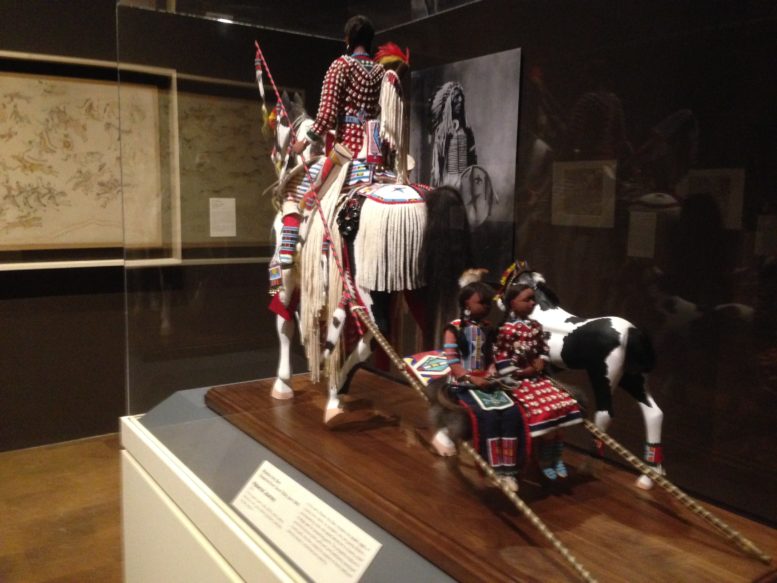 “Maternal Journey,” Rhonda Holy Bear of the Cheyenne River Sioux Tribe is on display as part of Indigenous Beauty: Masterworks of American Indian Art from the Diker Collection at the Toledo Museum of Art.
“Maternal Journey,” Rhonda Holy Bear of the Cheyenne River Sioux Tribe is on display as part of Indigenous Beauty: Masterworks of American Indian Art from the Diker Collection at the Toledo Museum of Art.

